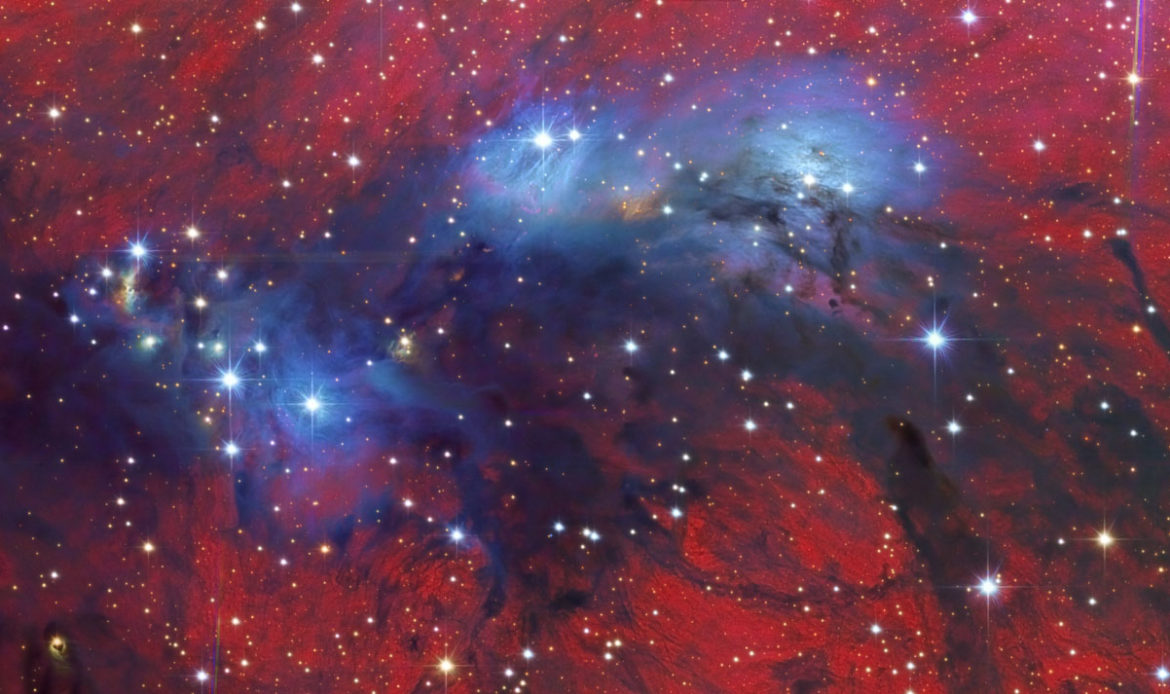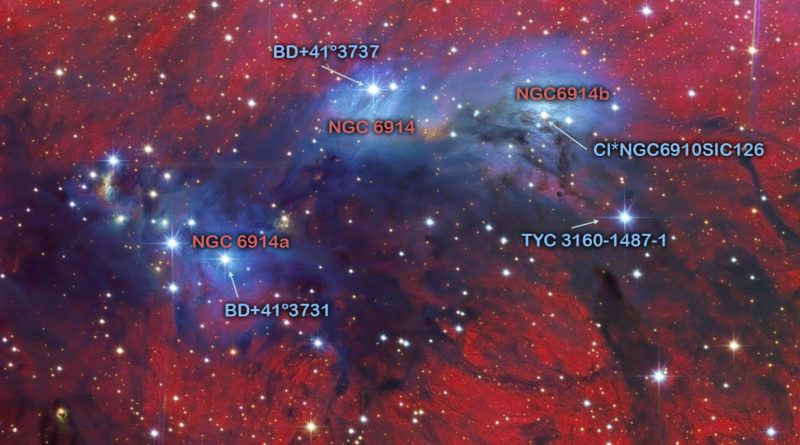Nebulae of many colours: The NGC 6914 complex Versión en español

In the deep space there are not only stars: galaxies like ours contain also nebulae, diffuse matter made up from gas and dust. These nebulae display a variety of shapes and colours that reflect the diversity of processes that arise when nearby star light gets tangled among them.
Interstellar nebulae
Almost all the universe is made up ofrom hydrogen and helium, thus composed of light and simple atoms; and interstellar nebulae aren’t an exception. But the interstellar medium is made up, in a small part, also from other materials like carbon, silicon or oxygen. These atoms tend to aggregate, building tiny grains that form what we know as interstellar dust. Thus, a normal nebula is made up from gas in a 99 % (hydrogen and helium) and a small proportion of material that composes the dust.
Interstellar dust and light
Interstellar dust builds up a small fraction of the mass of all nebulae, but its interaction with light is so intense that it defines their visual shape. Light that reaches the dust is partially scattered and partially absorbed. This phenomenon similar to what happens in the clouds of the Earth’s atmosphere: water droplets and tiny ice crystals reflect and scatter part of the light that hits them. That’s why, due to reflected light, clouds have a bright appearance when looked from the same side as they are illuminated. However, when the same clouds are observed from the opposite side, light is absorbed proportionally to their density and thickness. That’s why, when looking from below, the Sun is seen dimmed by the clouds. In the latter case, clouds appear to be deep gray, sometimes even almost black.
The effect of cosmic dust on stellar light is similar. A nebula containing a small amount of dust will look darker, or even black, when illuminating stars are in the background. In this case, we talk about dark nebulae. This same nebula, observed from the side where light is reflected, will appear bright. Interstellar dust is less reflective than the atmospheric clouds, but when the light from hot young stars reaches this dust, it shines with light blue tones. This is what we know as reflection nebulae. The blue cast of a reflection nebula is due not only to the colour of the hot stars, but also to the interaction of light with dust grains, that favors the scattering and reflection of blue light.

The nebular complex in the northern constellation Cygnus: a star-forming region containing nebulae of many kinds. North is rignt, east is up
Gas light
Nebular dust always comes with gas — mostly hydrogen. The same massive hot stars that illuminate dust can cause the pure gas to shine. Ultraviolet light from the most massive stars pulls out electrons from the hydrogen atoms. When these atoms get back their electron, they emit a characteristic reddish or pinkish light: the H-α and H-β radiation. This excited gas forms the emission nebulae, which are a the most outstanding feature of star-forming regions.
NGC 6914 nebulae
The nebular complex know as NGC 6914, in the northern Cygnus constellation, offers a clear case of combination of the three types of nebulae described above. This region concentrates gaseous and dusty masses of the Galactic plane, where stars are born. Fragments of nebula placed between the Earth and the young stars appear dark, with varying opacities and intricate shapes. In other areas, near the younger and hotter stars, dust shines with the bluish colours of reflection nebulae. Lastly, all the image is covered by ionized hydrogen that gives to the scene a reddish and warm backdrop. Newly born stars, which are only a few million years old, mill around the scene. Their colours reveal their diversity of masses and temperatures. But in this small portion of the Galaxy, about 6000 light-years away, massive and hot stars (O and B type stars) are so abundant that the area is classified as an OB association. Its name is Cygnus OB2.
The image
This photo of NGC 6914, obtained at Calar Alto Observatory, is released by Descubre Foundation, in collaboration with the Documentary School of Astrophotography (DSA) and the Astronomical Observatory of the University of Valencia (OAUV). The image captures this area of star formation in all its beauty. The patches of gas and dust include three main bright areas known as NGC 6914 (at the center), NGC 6914a (to the south, at left in the image) and NGC 6914b (to the north, at right in the image). Each bright nebula nucleus is centred at one or more massive, young hot stars. Some of these stars can be seen through small telescopes; but to discern details in the nebulae, a dark sky and a large aperture are really needed.

Identification of the most outstanding nebular patches and young stars in the nebular complex NGC 6914
The field of view in this image is 27 arc-minutes wide by 15 arc-minutes high, with north towards the right, and east is up. The image was acquired with the 1.23 meter Zeiss telescope at Calar Alto Observatory within the POP123 project of Descubre Foundation. It’s made up of data through RGB broadband and H-α narrowband filters, with a total integration time of 23 hours. To make this landscape format image, a two-panel mosaic was assembled. H-α data were used to separate reflection from emission nebulae in the red channel, in order to raise the contrast of the faint hydrogen structures. We think that this is perhaps the most detailed view of the object to date. Data acquisition and processing was carried out by Jack Harvey, Juan Conejero and Vicent Peris with all processing done in PixInsight.
Image download
Image credits: Calar Alto Observatory / Dedscubre Foundation / DSA / OAUV / Jack Harvey (DSA/SSRO/PTeam), Juan Conejero (DSA/PTeam), Vicent Peris (DSA/OAUV).
Image of the NGC 6914 nebular complex in Cygnus, from the Documentary Photo Gallery of Calar Alto. High resolution version (3240×1804), non-compressed TIFF, 16.7 MB.
Image with labels identifying the main nebular patches and stars in the nebular complex NGC 6914.
More information in English: details of the image processing witn PixInsight
Astronomy Picture of the Daty (APOD) March 4th 2011
Text: David Galadí-Enríquez

